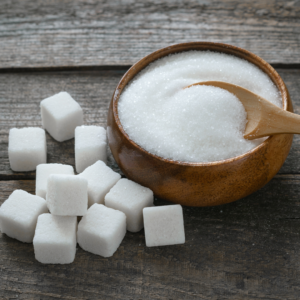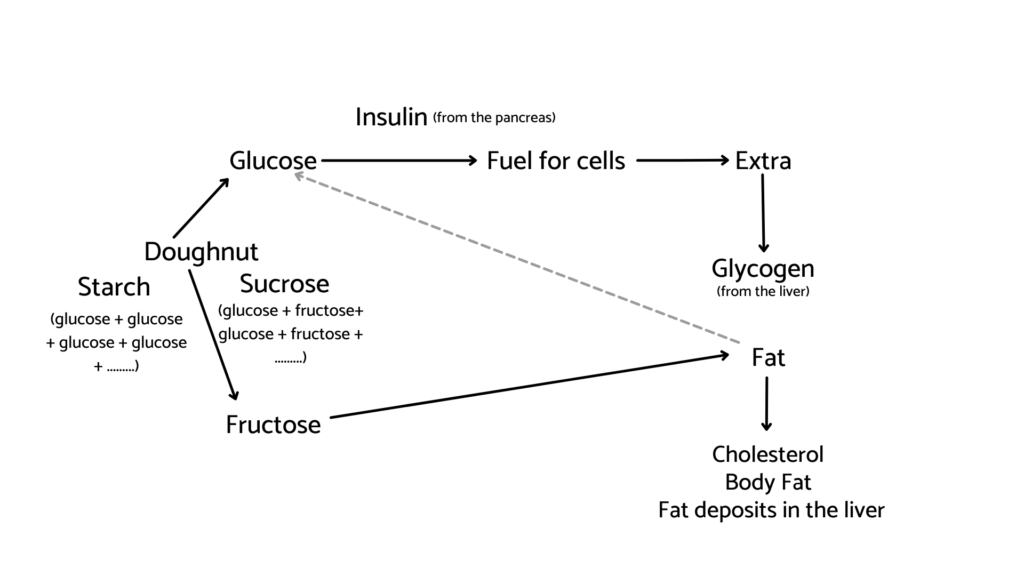Raise your hand if you’ve heard that sugar is evil or poison or just terrible for you. Is your hand up? Mine is.
If you’re just here to get an answer to a question, I’ll give you the goods up front:
- Sugar isn’t evil. Our body knows what to do with it and metabolize it.
- Until we eat too much of it, and then it becomes a problem. And eating too much of it can absolutely kill us.
I will dive into a longer answer, but before I do, I thought I’d give you some context about who I am. I have no affiliations with any company (sugar or otherwise). I have no vested interest in people cutting out sugar, or keeping sugar in their lives. I’m a former naturopathic doctor with a master’s degree in biology, so I’ve studied a lot of science, including how sugar works in the body. I don’t know everything about it, but I know a lot more than the average person. And as an ND, I worked with hundreds of patients, and talked about sugar with all of them.

Sugar is kind of a catch all for a specific group of carbohydrates. When we think of sugar, we’re usually thinking about sucrose, or table sugar, which is a sugar that consists of two simple sugars – glucose & fructose.
There are other types of sugar. Lactose, found in milk, is a sugar made of two simple sugars (glucose + galactose).
Glucose is the big guy in question here. Glucose is the one that we use as fuel in our bodies. We can’t survive without glucose. And glucose is in all sorts of things, beyond table sugar. A sweeping generalization I’m going to make is that any food that has any type of carbohydrate has glucose. There might be exceptions to that, but they don’t matter for our discussion here.
But let’s pick on a doughnut.
Doughnuts are made of all sorts of things, including flour and sugar. Flour is mostly glucose, sugar is glucose + fructose.
When we eat a doughnut, our body quickly digests it into the glucose and fructose. The glucose goes into our blood stream, which causes our blood sugar to spike.

When this happens, it wakes up our pancreas to produce insulin. Insulin comes streaming out, and it’s responsible for putting all of the sugar in our body away. So it gives some to the heart and the lungs and the muscles, and tucks extra away for later in the liver as glycogen.
And then we stop eating, and when our blood sugar gets low, our body can tap into the glycogen in the liver to put more fuel (glucose) into the blood stream.
But we often can’t store all of the glucose that we eat – there is A LOT in a doughnut! So when the tissues are full and the liver is full, the body can store extra as fat.
This fat can be turned back into glucose when we need it.
But we rarely need it, because we eat so much glucose.
One more thing – do you remember when I told you that table sugar also has fructose in it? Well, fructose can’t be directly used as a fuel. So the body turns it directly into fat, because the body can convert that fat to glucose when it needs to.
Where do we find fructose? It’s in honey and fruits. But it’s also in high fructose corn syrup, which is a cheap and easily available sweetener, which means fructose is basically in every processed food. s
But with our current diet, we don’t usually need to.
We spend all day putting glucose in at the top, that we never really run out of it.
What Happens When We Eat Too Much Sugar?
- Fat storage – that fat can look like body fat, high cholesterol, or even a fatty liver. Remember – we can turn that fat into fuel when we need it (we just never need it).
- Insulin resistance – remember insulin’s job is to put the glucose away? When we have too much glucose in our body, the pancreas produces a ton of insulin. And insulin, who is trying to get rid of that glucose, becomes that annoying neighbor. Always coming around, asking if you need any help. And eventually you stop answering the door because you know it’s your neighbor. You know that one? That’s insulin sensitivity. The body stops responding to it.
- Prediabetes & Type 2 diabetes – This is now where the body definitely has insulin sensitivity and blood sugar levels aren’t coming down. Early prediabetes and type 2 diabetes can be managed (and even reversed!!!) with diet, but if people don’t know how to properly do that, you can end up on medications with type 2 diabetes.
*Insulin sensitivity, diabetes, and blood sugar regulation in general is an incredibly complex system. There are a number of other reasons why people might experience insulin sensitivity (it’s very common in PCOS for example) and type 1 diabetes is a whole different ball game. So, I’m oversimplifying things here.
Ok – back to sugar.
So, our body does know how to metabolize sugar.
The problems come when we pump a ton of sugar into it, all day every day.
My Sugar Rules
Here are my 4 rules when it comes to eating sugar for myself, and my family.
- Fruits are wonderful, and delicious, but I try to stick to 2-3 servings a day. The fiber in fruit helps to offset the blood sugar spike, but there is still glucose and fructose in fruit, and I do try to be cognizant of servings each day. My kids and I usually end up having a serving (ish) with breakfast, and a serving as a snack.
- Know your serving sizes. One medium apple, banana, or orange is a serving. Around 1 cup of other fruit (so berries, melon, etc.) would be the equivalent of one serving.
- I try not to go over 20 g of added sugar each day. I don’t count fruit in that – I mean, one medium apple has 19 g of sugar. Where I count it is in packaged food. So if I’m going to have a packaged snack, or if I was to use a stir fry sauce for example. Or drinks. A lot of sugar hides in drinks. One can of coke has 39 g of sugar in it, which is double the amount you should be having in a day. Get to know what you eat, what a serving size is, and how much sugar is in each serving. And if you stick to the rule of “no more than 20 g of added sugar each day”, that’s a good goal.
- And I follow these 2 rules MOST of the time. Not all of the time. Because ice cream has more than 20 go of sugar per serving. And a cookie might too. But I’m conscious about not eating cookies every day.
If you start reading labels, you’ll start noticing how much sugar is in processed food. Even flavored yogurt, which a lot of people see as a healthy food, can have a lot of sugar. 7 g of sugar isn’t uncommon, so add that to your 20 g of total sugar in a day.
Here’s a few examples of how unpredictable sugar amounts can be. If you’re Canadian, you know Tim Horton’s. I went on their website and picked on a few of their products (sticking with my donut theme from earlier), and even these surprised me:
- A Boston cream donut from Tim’s has 13 g of sugar.
- A chocolate dip donut from Tim’s has 8 g of sugar.
- A blueberry muffin from Tim’s has 25 g of sugar.
- A chocolate chip muffin from Tim’s has 36 g of sugar.
- A raisin bran muffin from Tim’s has 36 g of sugar.
The raisin bran muffin threw me for a loop.
Something that’s perceived as healthy, that many people might grab for breakfast in the morning, has more than double the amount of sugar I’d recommend in a day.
Is sugar evil? No.
Can we eat too much of it? Yes.
Do we eat too much of it? Generally yes.
Is it something we should be mindful of? Also, yes.
That’s a very quick intro to sugar, but it’s something I think that everyone should know. Let me know if you have any questions about sugar!
